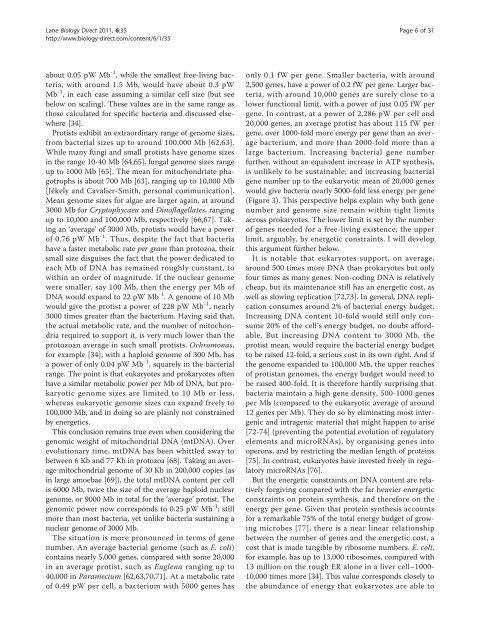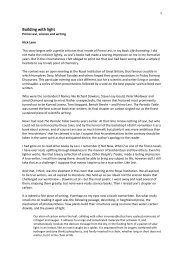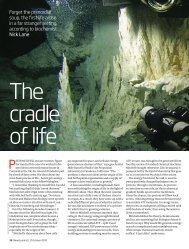Energetics and genetics across the prokaryote ... - Biology Direct
Energetics and genetics across the prokaryote ... - Biology Direct
Energetics and genetics across the prokaryote ... - Biology Direct
You also want an ePaper? Increase the reach of your titles
YUMPU automatically turns print PDFs into web optimized ePapers that Google loves.
Lane <strong>Biology</strong> <strong>Direct</strong> 2011, 6:35http://www.biology-direct.com/content/6/1/35Page 6 of 31about 0.05 pW Mb -1 , while <strong>the</strong> smallest free-living bacteria,with around 1.5 Mb, would have about 0.3 pWMb -1 , in each case assuming a similar cell size (but seebelow on scaling). These values are in <strong>the</strong> same range asthose calculated for specific bacteria <strong>and</strong> discussed elsewhere[34].Protists exhibit an extraordinary range of genome sizes,from bacterial sizes up to around 100,000 Mb [62,63].While many fungi <strong>and</strong> small protists have genome sizesin <strong>the</strong> range 10-40 Mb [64,65], fungal genome sizes rangeup to 1000 Mb [65]. The mean for mitochondriate phagotrophsis about 700 Mb [63], ranging up to 10,000 Mb[Jékely <strong>and</strong> Cavalier-Smith, personal communication].Mean genome sizes for algae are larger again, at around3000 Mb for Cryptophycaea <strong>and</strong> Dinoflagellates, rangingup to 10,000 <strong>and</strong> 100,000 Mb, respectively [66,67]. Takingan ‘average’ of 3000 Mb, protists would have a powerof 0.76 pW Mb -1 . Thus, despite <strong>the</strong> fact that bacteriahave a faster metabolic rate per gram than protozoa, <strong>the</strong>irsmall size disguises <strong>the</strong> fact that <strong>the</strong> power dedicated toeach Mb of DNA has remained roughly constant, towithin an order of magnitude. If <strong>the</strong> nuclear genomewere smaller, say 100 Mb, <strong>the</strong>n <strong>the</strong> energy per Mb ofDNA would exp<strong>and</strong> to 22 pW Mb -1 . A genome of 10 Mbwould give <strong>the</strong> protist a power of 228 pW Mb -1 , nearly3000 times greater than <strong>the</strong> bacterium. Having said that,<strong>the</strong> actual metabolic rate, <strong>and</strong> <strong>the</strong> number of mitochondriarequired to support it, is very much lower than <strong>the</strong>protozoan average in such small protists. Ochromonas,for example [34], with a haploid genome of 300 Mb, hasa power of only 0.04 pW Mb -1 , squarely in <strong>the</strong> bacterialrange. The point is that eukaryotes <strong>and</strong> <strong>prokaryote</strong>s oftenhave a similar metabolic power per Mb of DNA, but prokaryoticgenome sizes are limited to 10 Mb or less,whereas eukaryotic genome sizes can exp<strong>and</strong> freely to100,000 Mb, <strong>and</strong> in doing so are plainly not constrainedby energetics.This conclusion remains true even when considering <strong>the</strong>genomic weight of mitochondrial DNA (mtDNA). Overevolutionary time, mtDNA has been whittled away tobetween 6 Kb <strong>and</strong> 77 Kb in protozoa [68]. Taking an averagemitochondrial genome of 30 Kb in 200,000 copies (asin large amoebae [69]), <strong>the</strong> total mtDNA content per cellis 6000 Mb, twice <strong>the</strong> size of <strong>the</strong> average haploid nucleargenome, or 9000 Mb in total for <strong>the</strong> ‘average’ protist. Thegenomic power now corresponds to 0.25 pW Mb -1 ;stillmore than most bacteria, yet unlike bacteria sustaining anuclear genome of 3000 Mb.The situation is more pronounced in terms of genenumber. An average bacterial genome (such as E. coli)contains nearly 5,000 genes, compared with some 20,000in an average protist, such as Euglena ranging up to40,000 in Paramecium [62,63,70,71]. At a metabolic rateof 0.49 pW per cell, a bacterium with 5000 genes hasonly 0.1 fW per gene. Smaller bacteria, with around2,500 genes, have a power of 0.2 fW per gene. Larger bacteria,with around 10,000 genes are surely close to alower functional limit, with a power of just 0.05 fW pergene. In contrast, at a power of 2,286 pW per cell <strong>and</strong>20,000 genes, an average protist has about 115 fW pergene, over 1000-fold more energy per gene than an averagebacterium, <strong>and</strong> more than 2000-fold more than alarge bacterium. Increasing bacterial gene numberfur<strong>the</strong>r, without an equivalent increase in ATP syn<strong>the</strong>sis,is unlikely to be sustainable; <strong>and</strong> increasing bacterialgene number up to <strong>the</strong> eukaryotic mean of 20,000 geneswould give bacteria nearly 5000-fold less energy per gene(Figure 3). This perspective helps explain why both genenumber <strong>and</strong> genome size remain within tight limits<strong>across</strong> <strong>prokaryote</strong>s. The lower limit is set by <strong>the</strong> numberof genes needed for a free-living existence; <strong>the</strong> upperlimit, arguably, by energetic constraints. I will developthis argument fur<strong>the</strong>r below.It is notable that eukaryotes support, on average,around 500 times more DNA than <strong>prokaryote</strong>s but onlyfour times as many genes. Non-coding DNA is relativelycheap, but its maintenance still has an energetic cost, aswell as slowing replication [72,73]. In general, DNA replicationconsumes around 2% of bacterial energy budget.Increasing DNA content 10-fold would still only consume20% of <strong>the</strong> cell’s energy budget, no doubt affordable.But increasing DNA content to 3000 Mb, <strong>the</strong>protist mean, would require <strong>the</strong> bacterial energy budgetto be raised 12-fold, a serious cost in its own right. And if<strong>the</strong> genome exp<strong>and</strong>ed to 100,000 Mb, <strong>the</strong> upper reachesof protistan genomes, <strong>the</strong> energy budget would need tobe raised 400-fold. It is <strong>the</strong>refore hardly surprising thatbacteria maintain a high gene density, 500-1000 genesper Mb (compared to <strong>the</strong> eukaryotic average of around12 genes per Mb). They do so by eliminating most intergenic<strong>and</strong> intragenic material that might happen to arise[72-74] (preventing <strong>the</strong> potential evolution of regulatoryelements <strong>and</strong> microRNAs), by organising genes intooperons, <strong>and</strong> by restricting <strong>the</strong> median length of proteins[75]. In contrast, eukaryotes have invested freely in regulatorymicroRNAs [76].But <strong>the</strong> energetic constraints on DNA content are relativelyforgiving compared with <strong>the</strong> far heavier energeticconstraints on protein syn<strong>the</strong>sis, <strong>and</strong> <strong>the</strong>refore on <strong>the</strong>energy per gene. Given that protein syn<strong>the</strong>sis accountsfor a remarkable 75% of <strong>the</strong> total energy budget of growingmicrobes [77], <strong>the</strong>re is a near linear relationshipbetween <strong>the</strong> number of genes <strong>and</strong> <strong>the</strong> energetic cost, acost that is made tangible by ribosome numbers. E. coli,for example, has up to 13,000 ribosomes, compared with13 million on <strong>the</strong> rough ER alone in a liver cell–1000-10,000 times more [34]. This value corresponds closely to<strong>the</strong> abundance of energy that eukaryotes are able to





